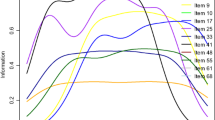Abstract
Separation from the family, a key developmental task, has received scant attention from developmentalists. In this study, college students' dissimilarity ratings and ratings on 22 bipolar adjective scales were obtained for a set of 20 definitions of home-leaving. Results of a cluster analysis revealed that conceptualizations of the definitions are organized in terms of eight clusters. Ratings on the 22 adjective scales provided an empirical means for interpreting the typological structure of the home-leaving definitions. Convergence the results of this inductive study of home-leaving and elements of ego development theory was noted.
Similar content being viewed by others
References
Ainsworth, H. D. S., and Wittig, B. A. (1969). Attachment and exploratory behavior of one-year-olds in a strange situation. In Foss, B. M. (ed.),Determinants of Infant Behavior, Vol. IV, Methuen, London, pp. 111–136.
Antonucci, T. (1976). Attachment: A life-span concept.Hum. Dev. 19: 135–142.
Bekoff, M. (1977). Mammalian dispersal and the ontogeny of individual behavioral phenotypes.Am. Naturalist 111: 715–732.
Bell, S. M. (1970). The development of the concept of object as related to infant-mother attachment.Child Dev. 41: 291–311.
Blos, P. (1967). The second individuation process of adolescence.Psychoanal. Stud. Child 72: 162–186.
Bowlby, J. (1969).Attachment and Loss, Vol. 1:Attachment, Basic Books, New York.
Coelho, G., Solomon, F., Wolff, C., Steinberg, A., and Hamburg, D. (1969). Predicting coping behavior in college.J. Nerv. Ment. Dis. 14: 386–397.
Dimock, H. S. (1937).Rediscovering the Adolescent: A Study of Personality Development in Adolescent Boys, Association Press, New York.
Douvan, E., and Adelson, J. (1966).The Adolescent Experience, Wiley, New York.
Elson, N. (1964). The reactive impact of adolescent and family upon each other in separation.J. Am. Acad. Child Psychol. 3: 669–708.
Hotch, D. (1979). Separating from the family: A study of perceptions of home-leaving in late adolescence. Doctoral dissertation, Michigan State University.
Johnson, S. (1967). Hierarchical clustering schemes.Psychometrika 38: 241–254.
Josselson, R. (1980). Ego development in adolescence. In Adelson, J. (ed.),Handbook of Adolescent Psychology, Wiley, New York.
Kestenbaum, C. J. (1978). Some practical considerations in the assessment and treatment of adolescent girls with separation problems.J. Am. Acad. Psychoanal. 6: 353–368.
Lerner, R. M., and Ryff, C. D. (1978). Implementation of the life-span view of human development: The sample case of attachment. In Baltes, P. B. (ed.),Life-Span Development and Behavior, Vol. 1, Academic Press, New York.
Marcia, J. (1966). Development and validation of ego identity status.J. Personal. Soc. Psychol. 3: 551–558.
Marcia, J. (1980). Identity in adolescence. In Adelson, J. (ed.),Handbook of Adolescent Psychology, Wiley, New York.
Murphey, E., Silber, E., Coelho, G., Hamburg, D., and Greenburg, I. (1963). Development of autonomy and parent-child interaction in late adolescence.Am. J. Orthopsychiat. 33: 643–652.
Shapiro, A. (1969). Adolescent ego autonomy and the family. In Caplan, G., and Lebovici, S. (eds.),Adolescence: Psychosocial Perspectives, Basic Books, New York.
Sherman, A. (1946). Emancipation of college students.J. Genet. Psychol. 68: 171–180.
Stierlin, H., Levi, L. D., and Savard, R. J. (1971). Parental perceptions of separating children.Fam. Proc. 10: 411–427.
Sullivan, K., and Sullivan, A. (1980). Adolescent-parent separation.Dev. Psychol. 16: 93–104.
Troll, L. E., and Smith, J. (1976). Attachment through the life-span: Some questions about dyadic bonds among adults.Hum. Dev. 19: 156–170.
Waterman, A. S., and Waterman, C. K. (1971). A longitudinal study of changes in ego identity status during the freshman year at college.Dev. Psychol. 5: 167–173.
Weiner, B., Russell, D., and Lerman, D. (1979). The cognition-emotion process in achievement-related contexts.J. Personal. Soc. Psychol. 37: 1211–1220.
Author information
Authors and Affiliations
Additional information
Received Ph.D. from Michigan State University in 1979. Major research interests are moral development, parent-adolescent separation, and attribution theory.
Received Ph.D. from Michigan State University in 1979. Major research interests are parent-adolescent separation, attitudes/values in adolescence, and evaluation research.
Rights and permissions
About this article
Cite this article
Moore, D., Hotch, D.F. Late adolescents' conceptualizations of home-leaving. J Youth Adolescence 10, 1–10 (1981). https://doi.org/10.1007/BF02088418
Received:
Issue Date:
DOI: https://doi.org/10.1007/BF02088418




